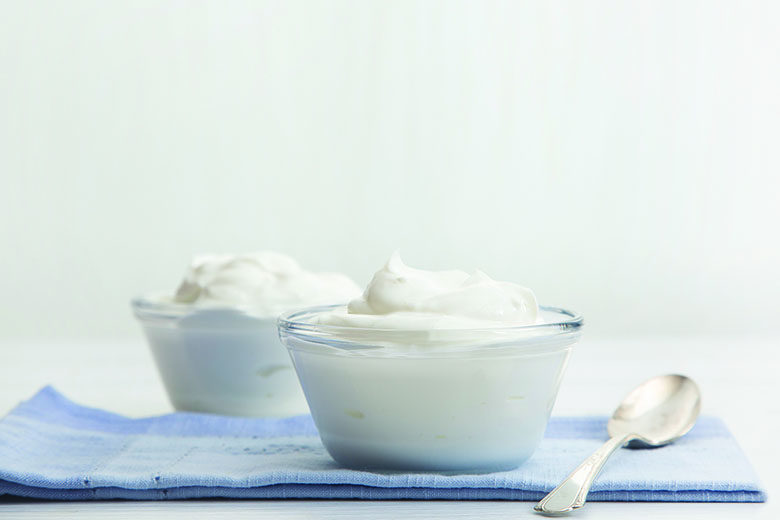
Yogurt isn’t just a powerhouse of nutrition, it’s a workhorse in the kitchen, handy for many ingredient substitutions. Most of the following hacks feature plain Greek yogurt, which tends to be easier to find in stores compared to plain regular yogurt. Greek yogurts without gum, gelatin or pectin work best. If your intention is to lower consumption of sodium and carbohydrates while increasing protein, reduced-fat Greek yogurt is a better choice than plain low-fat yogurt. However, regular yogurt does offer more calcium than many Greek varieties.
General Substitutions
It’s simple to use reduced-fat (2%) Greek yogurt in a 1:1 ratio in place of creamy, higher-fat, tangy ingredients such as sour cream or crème fraiche. In place of ingredients such as ricotta cheese, cream cheese, mascarpone, heavy cream or mayonnaise, use roughly half the original ingredient and half yogurt. Heavy cream often is added to hot soups or sauces because it doesn’t curdle in the heat; to prevent yogurt from curdling, don’t use fat-free yogurt and add yogurt after removing from heat. If soups or sauces need to be reheated, warm gently; never boil or simmer.
Baking Substitutions
For 1 cup butter, use ½ cup butter plus ¼ cup 2% Greek yogurt. For 1 cup oil, substitute ⅓ cup oil plus ⅔ cup yogurt. For 1 cup buttermilk, use ⅓ cup milk plus ⅔ cup yogurt or try equal parts. For 8 ounces cream cheese, use 4 ounces cream cheese plus ½ cup yogurt.
Marinade and Rubs
In Mediterranean and Indian recipes, regular (not Greek) yogurt is used as a marinade to help tenderize lamb, goat, pork or chicken. Marinate for a few hours in the refrigerator before removing meat from the yogurt and discarding the marinade, then roast. Because of its thicker consistency, Greek yogurt can be rubbed on tender cuts of meat; the yogurt does not need to be removed before cooking and will insulate the meat from moisture loss. For a pound of meat such as pork tenderloin, rub 2 to 4 ounces of Greek yogurt on the meat before roasting. Yogurt marinades and rubs are good flavor carriers for herbs and spices such as rosemary, sage, thyme, curry powder, black pepper, crushed red pepper and salt.
Whipped Cream
Yogurt whipped cream tastes rich and a tiny bit tangy, a welcome contrast when served on a sweet dessert. Add ¾ cup Greek yogurt, ⅔ cup heavy cream, 2 tablespoons sugar and ½ teaspoon vanilla extract to a chilled bowl. Beat first on low and then on high until stiff peaks form.
DIY
Make yogurt at home in a yogurt maker, slow cooker or multi-cooker. Depending on the recipe, the process takes about eight to 12 hours in a yogurt maker or multi-cooker and about 12 to 14 hours in a slow cooker. To make 3 to 4 cups of yogurt, use 2 quarts milk and ¼ cup store-bought yogurt. Pick a flavor you enjoy, since that’s how the final product will taste. For more protein, add nonfat dry milk powder or strain the yogurt longer to make Greek yogurt. Save the strained whey for smoothies or use it in quick breads in place of buttermilk.
References
Are all yogurts created equal? Not exactly. K-State Research and Extension Service website. Published October 23, 2015. Accessed January 9, 2020.
Ball S, Segrave-Daly D. The 30-Minute Mediterranean Diet Cookbook. Emeryville, CA: Rockridge Press; 2019:158-159.
Greek Yogurt Substitutions. Cabot website. Accessed January 9, 2020.
Lopez-Alt K. The Food Lab: Better Home Cooking through Science. 1st ed. New York, NY. W.W. Norton & Company; 2015:327-328.
Making Yogurt at Home. University of Alaska Fairbanks Cooperative Extension Service website. Accessed January 9, 2020.

